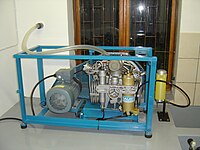
Photo from wikipedia
Thermal cracking and permeability evolution of granite under high temperature and triaxial compression are the key to designing high-level waste disposal sites. In this paper, uniaxial compression tests of granite… Click to show full abstract
Thermal cracking and permeability evolution of granite under high temperature and triaxial compression are the key to designing high-level waste disposal sites. In this paper, uniaxial compression tests of granite specimens with different axial compression are designed, and then a solid-head-designed coupling triaxial testing system is applied to study thermal cracking and permeability evolution of granite specimen with different damage at different inlet gas pressures (1, 2, 4, and 6 MPa) and temperatures (ranging from 100 to 650°C). The test results show that granite, nearly impermeable rocks, can show a striking increase of permeability by heating beyond the critical temperature. When the initial axial pressure is 60% or 70% of the uniaxial compressive strength, the growth of granite permeability exhibits three stages during 100∼650°C heating process. Permeability increases by two orders of magnitude, but it does not reach the maximum value (i.e., a network of interconnected cracks is not fully formed in the specimen). With increasing initial damage, permeability shows a sharp increase. Permeability increases by three orders of magnitude, it is in equilibrium state, and a network of interconnected cracks is fully formed in the specimen. Permeability of granite has a critical temperature at which permeability increases sharply. When the temperature is lower than the critical temperature, the magnitude of permeability is 10−18 m2 with a slight increase. When temperature is higher than the critical temperature, the magnitude of permeability is 10−15 m2 with a sharp increase. The critical temperature is related to the initial damage of specimen, and the critical temperature is smaller with the initial damage going larger. Therefore, studying thermal cracking and permeability evolution of granite with different initial damage under high temperature and triaxial compression is expected to provide necessary and valuable insight into the design and construction of high-level waste disposal structures.
Journal Title: Advances in Materials Science and Engineering
Year Published: 2018
Link to full text (if available)
Share on Social Media: Sign Up to like & get
recommendations!